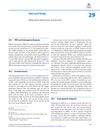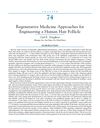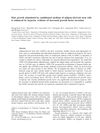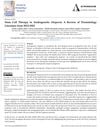TLDR Adipose-derived stem cells show promise in treatments but need more research for safety, especially in cancer.
Adipose-derived stem cells (ADSCs) were explored for their potential in medical treatments due to their ability to differentiate into various cell types and secrete growth factors. They were easier to harvest and yielded more cells than bone marrow-derived stem cells, showing promise in tissue engineering, wound healing, bone regeneration, and hair growth. However, the review highlighted uncertainties regarding their safety and effectiveness, particularly in cancer treatment, as ADSCs could both inhibit and promote tumor growth through growth factor secretion. Conflicting study results and the complexity of ADSCs' interactions with cancer cells underscored the need for further research to ensure safe therapeutic applications.
115 citations
,
August 2020 in “International Journal of Molecular Sciences” A PRP concentration of 1.0 × 10^6 plt/μL is best for tissue repair.
113 citations
,
July 2020 in “International Journal of Molecular Sciences” Allogenic ASCs and ECM transplants are safe and effective for tissue regeneration.
 55 citations
,
May 2017 in “Current stem cell research & therapy”
55 citations
,
May 2017 in “Current stem cell research & therapy” Using fat-derived stem cells for hair loss treatment is safe and effective, improving hair growth and patient satisfaction.
 8 citations
,
January 2016 in “Journal of Veterinary Medical Science”
8 citations
,
January 2016 in “Journal of Veterinary Medical Science” Lab-made tissues from dog fat stem cells can help grow hair by releasing a growth factor.
 2 citations
,
May 2024 in “European journal of medical research”
2 citations
,
May 2024 in “European journal of medical research” A special medium from stem cells significantly boosts hair growth and could help treat hair loss.
 January 2019 in “Springer eBooks”
January 2019 in “Springer eBooks” PRP may help with hair loss and improve hair quality with few side effects, but more research is needed.

New treatments for hair loss show promise, including plasma, stem cells, and hair-stimulating complexes, but more research is needed to fully understand them.
 134 citations
,
January 2010 in “Biomedical research”
134 citations
,
January 2010 in “Biomedical research” Low oxygen conditions increase the hair-growing effects of substances from fat-derived stem cells by boosting growth factor release.

Stem cell therapy shows promise for treating hair loss in androgenetic alopecia.






